The second instalment of the UEFA Nations League began this month, kickstarting international football for the first time since the outbreak of Coronavirus. In the second round of fixtures on September 6, Spain faced Ukraine in a match in group A4. Spain drew their first match of the campaign 1-1 to Germany, while Ukraine began the day at the top of the group following a 2-1 win against Switzerland.
With the top team in each group qualifying for the final four of the Nations League, both teams wanted to preserve their unbeaten starts in the second matchday of six. In this tactical analysis, we will explore the ways in which the two nations approached the game, the tactics they employed, and ultimately conclude why Spain dominated the match and picked up all three points.
Lineups
Spain made six changes from their draw against Germany, with Sergio Reguilón coming in at left-back and Dani Olmo replacing Carvajal (and therefore pushing Jesús Navas back to right-back). Gerard Moreno and Ansu Fati completed the attacking line in Luis Enrique’s front three, with Mikel Merino and Rodri replacing Sergio Busquets and Fabián Ruiz.
Ukraine manager Andriy Shevchenko also opted for a 4-3-3 and made no changes to his back five from the win against Switzerland. Ihor Kharatin came into the midfield, replacing Taras Stepanenko. Andriy Yarmolenko was the only of the front three to keep his place, with Marlos and Roman Yaremchuk being called in.
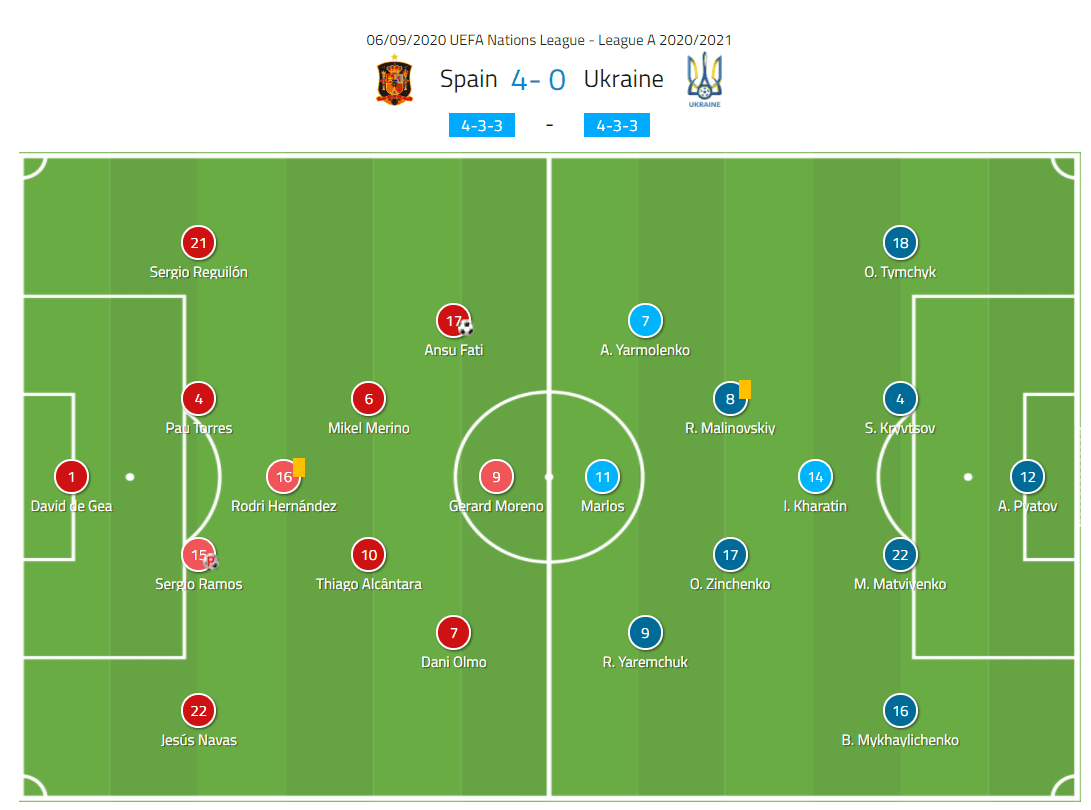
Ukraine’s defensive shape
With Spain entering as obvious favourites and with a clear desire to keep the football, Ukraine aimed to set up rigidly in defence and allow Spain possession of the football in areas higher up the pitch. They tried to sit off Spain and had a PPDA of 47.5 in the opening stages. While just 23.9% of Spain’s possessions in the match were ‘short’ (under 10 seconds), 62.3% of Ukraine’s could be described as such. Clearly, Shevchenko was interested in letting Spain have possession and then trying to counter-attack. 88% of Spain’s possessions reached Ukraine’s half, exemplifying their low pressing tendencies.
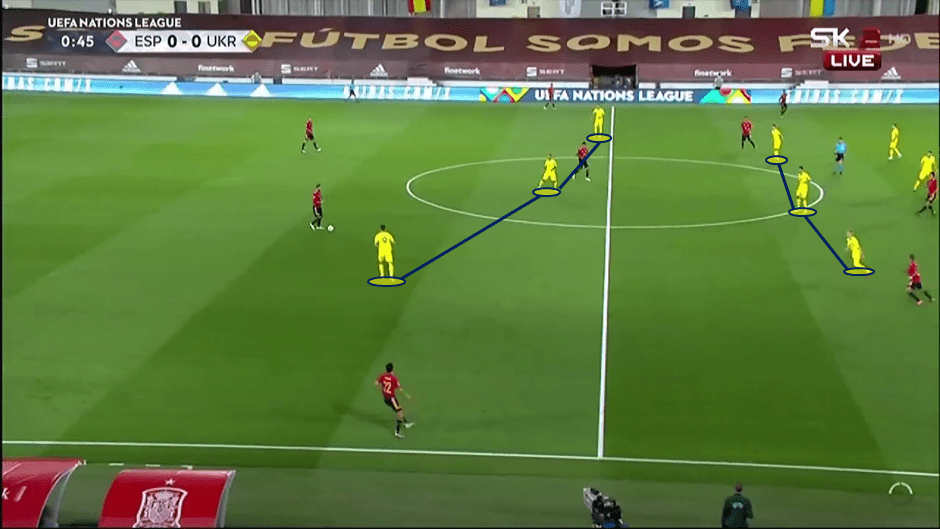
The still above displays the horizontality of Ukraine’s defensive shape. The three attackers stuck narrow and close, with no desire to close the ball-carrying defender. Instead, they would seek to cut passing lanes to the midfielders. Ukraine’s midfield three took up a similar shape but would aim to stay relatively close to Spain’s midfielders. Players like Thiago and Olmo are dangerous on the ball and can unpick a team with their passing and dribbling abilities. It was important therefore for Ukraine’s attackers to prevent the ball from reaching these players, and their midfielders to close them if it did.
Should Spain break the rigid lines of Ukraine, Shevchenko’s midfield three and wingers would aim to crowd the man on the ball and allow him no passing options. The back four would keep straight and narrow, so as to nullify any threat that may manifest itself in the box. The still below highlights these two factors, with the defence in a straight, narrow line, and four midfielders aiming to crowd Olmo on the ball. Throughout the game, the Ukraine players worked hard to get themselves behind the ball and make challenges – they embarked upon 125 duels and made 43 interceptions and 16 clearances.
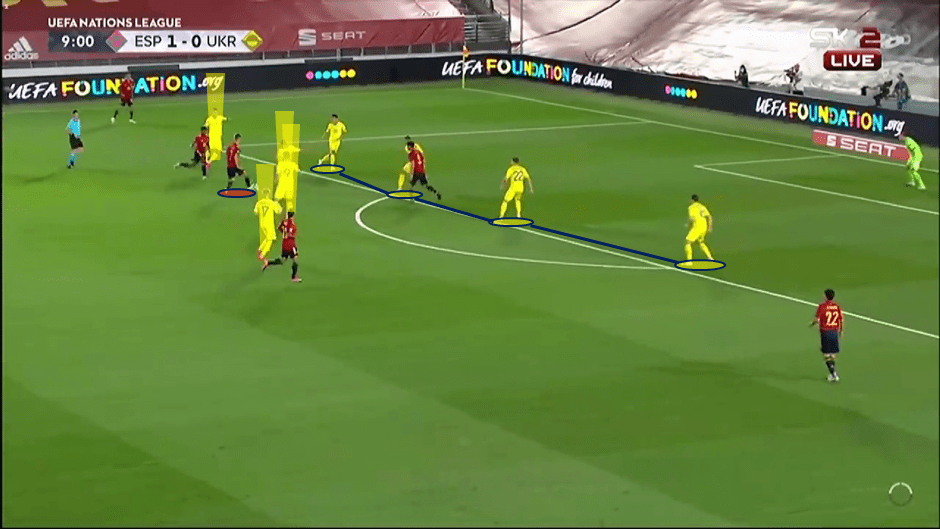
Spain’s exploitation of the wings
With an awareness of Ukraine’s desire to sit deep and narrow, Enrique instructed his players to utilise the wide areas – 40 of Spain’s 59 attacks stemmed from the flanks. He deployed two wingers and the full-backs – Navas and Reguilón – much more resembled wing-backs throughout. From the off, Spain posed a threat on the left with Barcelona wonderkid Fati linking up with Reguilón.
Inside the first two minutes, Spain patiently knocked the ball among their defenders and then shifted it out to Reguilón, who found Fati up the line. The youngster beat the first challenge, breaking Ukraine’s rigid midfield setup. He was greeted with the scene shown below. As the defence backed off, Fati could drive further up the pitch.
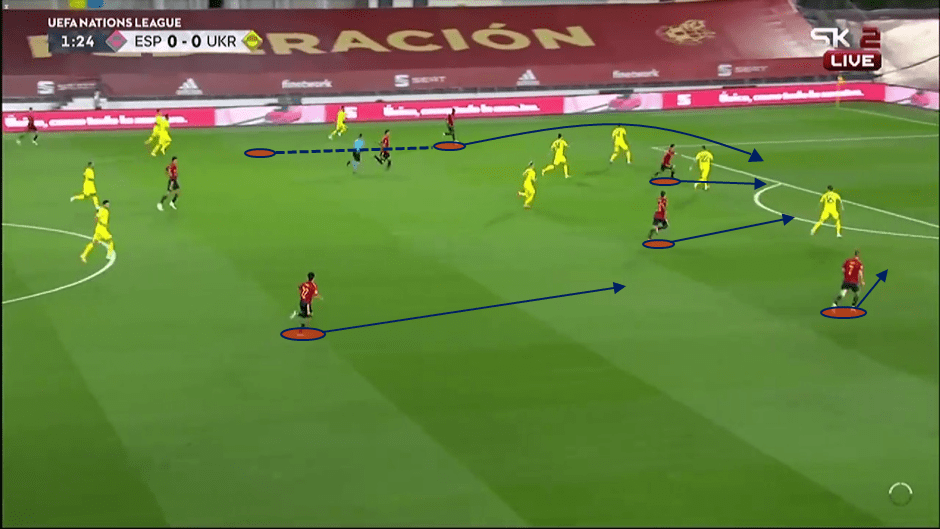
He broke into the box and was brought down for a penalty, which Real Madrid and Spain captain Ramos converted, giving Spain an early lead. However, this was a signal for what was to come. Fati’s pace and close control terrorised Ukraine all night.
We can also see in the still above the desire of Spain’s attackers to get into the box should a cross come in. Olmo frequently took up a narrower position, especially when the ball was out on the left, so as to attack the back of the box. We can see Navas driving forward into space also – something that Spain’s full-backs were clearly instructed to do throughout. Thiago, who was given a free role, can also be seen in an advanced area supporting the attack, alongside striker Moreno. Spain were willing to commit bodies forward and put Ukraine on the back foot. If they could break the shape of the first two lines of defence, Spain would be able to run riot.
Throughout the match, Spain cleverly held onto the ball and, when the time was right, one of the centre-backs shifted it out to the left to create an overload (Ramos and Torres made 31 progressive passes between them in the match). In fact, it was one of these overloads which won the corner Spain converted to make it 2-0.
The use of the overlap
Due to the height Spain’s wing-backs were playing with, and the narrowness of Ukraine’s, there was often a lot of room available which could be exploited after a quick switch of play. Fati and Reguilón frequently overloaded Ukraine’s right-hand side and many of Spain’s chances (38% of attacks and 1.24xG) originated from them two. The frame below shows Fati controlling the ball subsequent to a switch of play by Olmo.
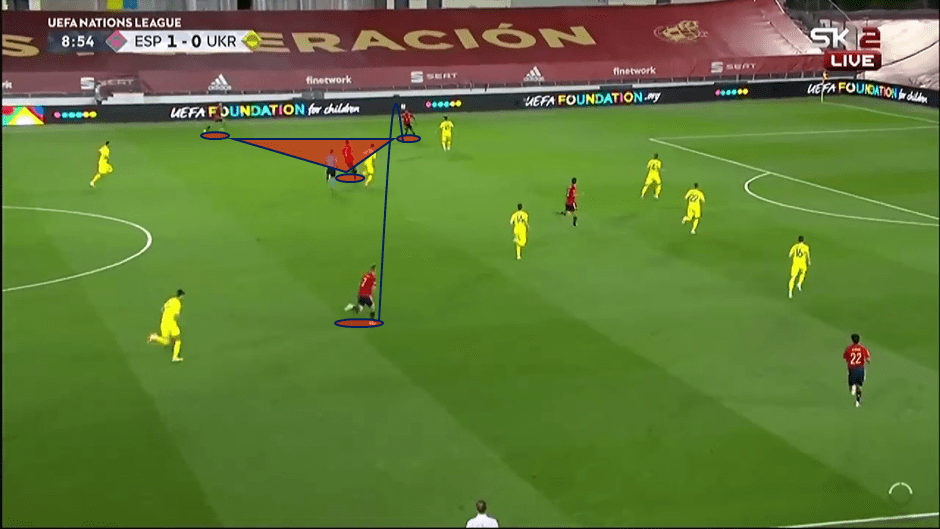
Upon the switch of play, one of Spain’s midfield trio (in the case above it was Merino) would drift into the half-space to create a triangle with full-back and winger, thus giving plenty of options for quick one-twos and varied forward runs. Spain’s pass map from the match is below, and it shows the triangles they sought to create in attack – with Merino on the left and Thiago on the right. This meant that Rodri acted as the one-man pivot ahead of the centre-halves. With a darker line representing a more frequent passing route, note the frequency at which Spain’s defence and Rodri leant the ball to one another throughout the game during their patient build-ups. Spain made 88 passes into the final third and 25 into the box, showing the effectiveness of the build-up.
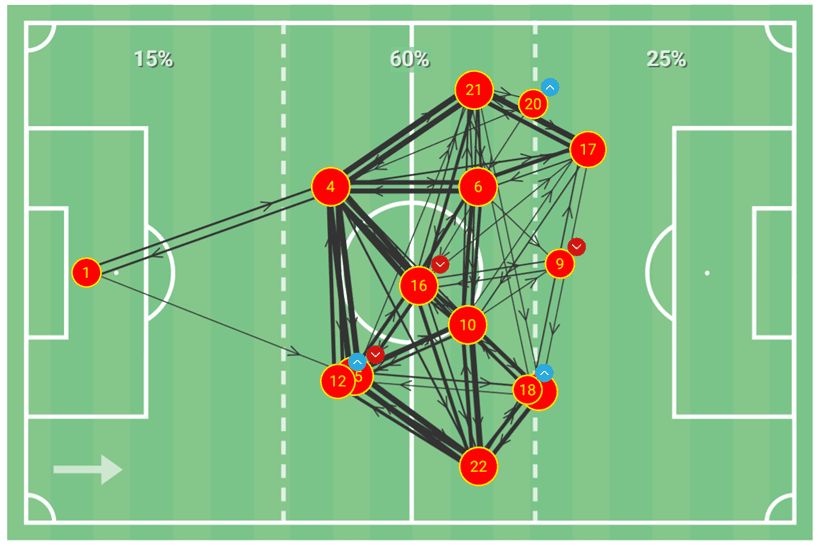
With Reguilón advancing in the above picture, we can see the immediate threat of a two-on-one situation. Using his pace to break past the midfield, Reguilón would often overlap Fati, giving the option of a ball being played down the line. Such a movement presents a dilemma to the Ukraine full-back, Tymchyk. If he tracks the overlapping Reguilón, he allows Fati space to cut inside and attack the heart of the defence; if he sticks with Fati, he runs the risk of Reguilón receiving the ball in behind the defence out wide. Both occurred frequently on the night, as Tymchyk was isolated and helpless. Reguilón put in eight crosses and assisted five shots, while Fati attempted eight dribbles and had six shots himself.
The third goal came from a similar situation, with the use of the overlap proving key. Spain pressed Ukraine high from their own throw-in, and after a few passes, Reguilón intercepted the ball on the half way line and gave the ball to Fati. He drove at the Ukraine defence but Tymchyk and Ukraine’s pivot Kharatin both came to meet him on the corner of the box, as shown below.
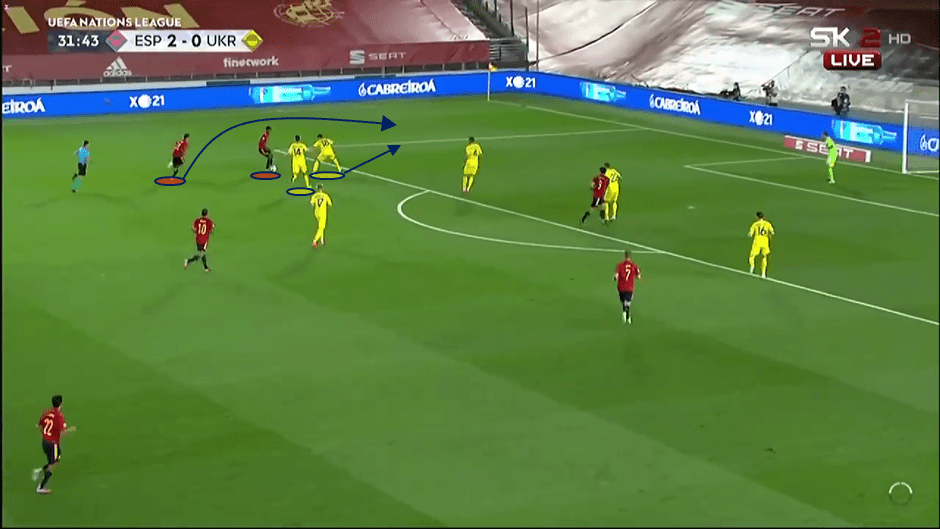
Reguilón accelerated past Fati on the outside, knowing Tymchyk would close him down to avoid a cross from the Spain full-back. With Fati now one-on-one, he was able to dart inside of Kharatin, who himself was occupied by the threat of Reguilón. With Kharatin on his heels, Fati shifted the ball onto his right and fired it into the far corner – scoring Spain’s third and wrapping up the points before half time. Without the positive run of Reguilón, Fati would have remained closed down and unable to shoot. As Tymchyk was aware of the overlapping threat, he had to track Reguilón, which ultimately awarded Fati enough space to work his magic.
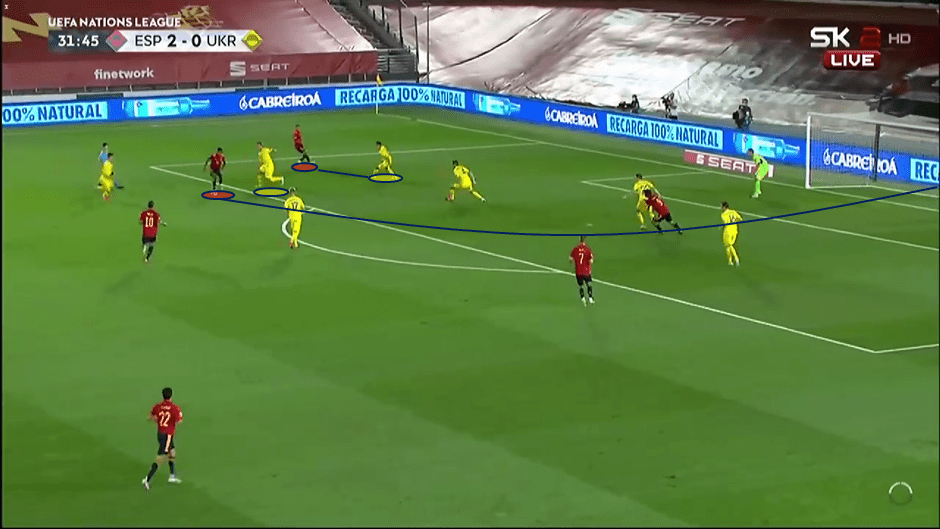
Ukraine’s counter-attacking aims
Although Ukraine only managed 32% of possession, they had a clear plan in attack. While their front three stayed narrow and rigid in defence, in transition the wingers would attack the wide areas and look for a ball in behind Spain’s defence – especially as the full-backs of Spain were so high in attack. Upon winning back possession, Ukraine would aim to quickly find their midfielders who would seek to release one of the wingers or overlapping full-backs. Just 15.1% of Ukraine’s attacks lasted longer than 20 seconds, exemplifying their aim to hit Spain quickly in transition.
35% of Ukraine’s passes were forward, and 11.9% were long. The still below shows Ukraine on the attack following a long, forward pass from goalkeeper Pyatov to Yarmolenko, who had drifted inside from the left. He played the ball to striker Yaremchuk, who sought to release Mykhaylichenko, the Ukraine left-back. With Navas sucked in by Yarmolenko’s run, the full-back had plenty of space to attack in behind. As Navas was out of position, one of Spain’s centre-backs was forced wide to cover. This ultimately gave Yaremchuk more space in the box to attack should the ball reach him. Also, note the space Marlos found himself in on the far side as Reguilón was caught high following an attack.
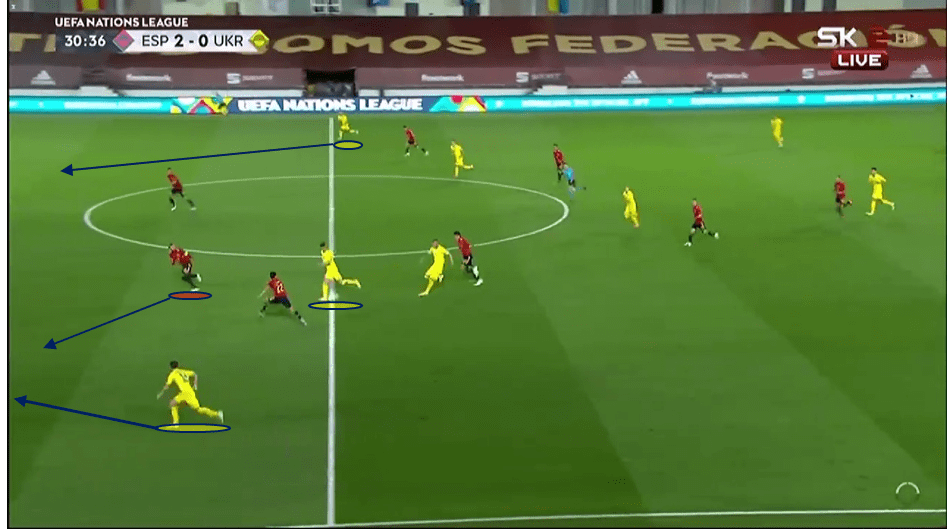
In fact, Ukraine’s biggest chance of the game came from an attack out wide. With Spain defending narrow in the closing stages, Tymchyk took the rare opportunity to get forward and he was found by Malinovskiy with an abundance of space. He was able to drive forward unchallenged and deliver a cross to the onrushing Yaremchuk. Substitute Viktor Kovalenko made a clever run to the corner of the box, taking four Spain players with him which allowed the space for Yaremchuk in the area. Unfortunately, it was a tame effort but displayed how Ukraine had been seeking to structure their attacks all evening.
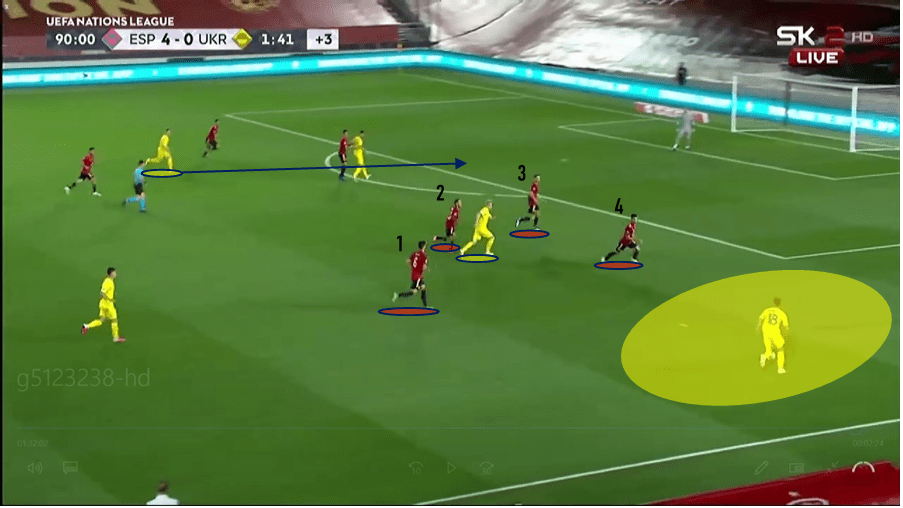
The role of Zinchenko
Ukraine’s best and busiest player on the night was certainly Zinchenko of Manchester City. He was deployed as a central midfielder with strict defensive responsibilities, but in attack had a much freer role. He attempted the second most actions of any Ukraine player, with 64, and his tally of 36 passes was the highest on his team.
Despite being deployed as the left-sided midfielder, when building-up, Zinchenko would often drop in alongside the central-defensive midfielder Kharatin (who would shift right), giving Ukraine the look of a 2-4 formation when the keeper had the ball.
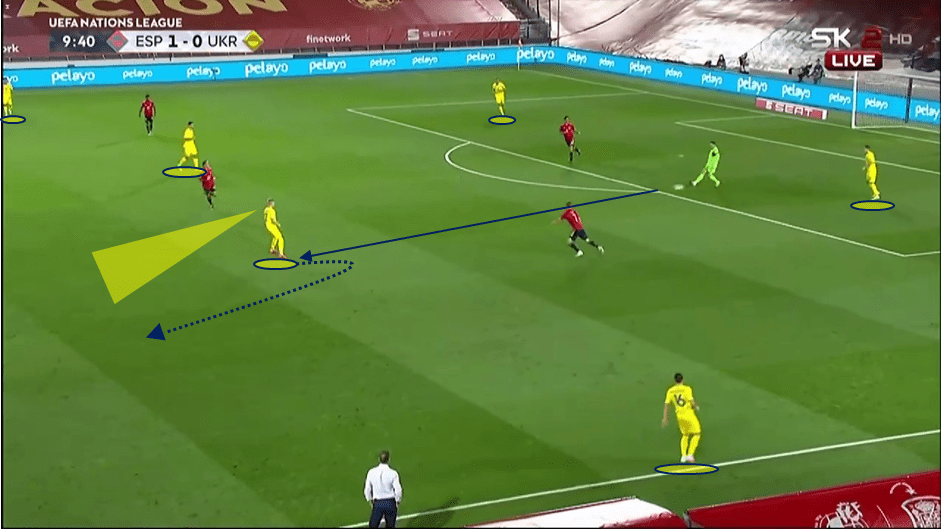
By dropping this bit deeper, Zinchenko broke the lines and had more space when he received the ball. After checking his shoulder in the still above, Zinchenko was able to receive the ball and turn. He quickly looked to send the ball in-behind to either Yarmolenko on the left or to Yaremchuk up the middle. By having a natural left-footer on the left side of midfield, through balls can be whipped with a spin that goes towards the opposition goal, as opposed to the by-line, thus creating more imminent danger.
As well as coming deeper and looking to build attacks himself, Zinchenko would also seek to drift into other, much higher areas of the pitch. He was clearly given a degree of freedom by Shevchenko to attack spaces your orthodox left-central midfielder would not. In the still below, Zinchenko received the ball from a throw-in in the centre of the pitch and shifted it wide to Yarmolenko.
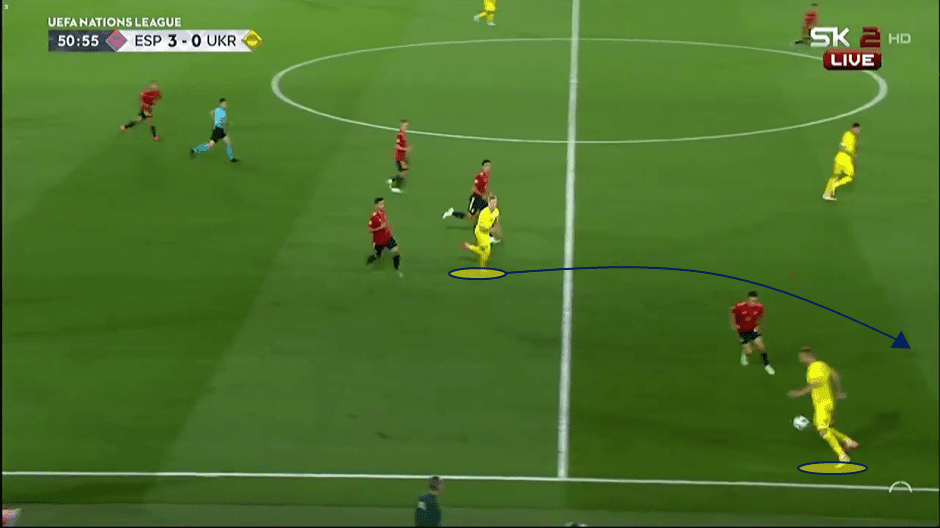
Instead of admiring his pass, Zinchenko cut across the pitch and made a run in behind the right of Spain’s of defence. With Yarmolenko being closed by the full-back, there was space to exploit. Although the ball didn’t reach him, the run showed the positivity and intelligence Zinchenko possesses in an attacking sense. Ukraine struggled to keep possession throughout, but if they had more players with the brains and ability of Zinchenko, they’d have posed much more of a threat.
Spain’s press
Spain must also be commended for the clean sheet, and this was helped by their high press. When they didn’t have the ball, they would press quickly but cleverly in an attempt to win it back as soon as possible. This tactic was a success, meaning Ukraine had little possession and posed little threat to Spain’s goal (they only managed an xG of 0.51, 0.37 of which came in the 92nd minute).
While the press would often resemble something of a man-to-man system – whereby the player on the ball would be closed by the nearest Spain player – Enrique’s men desired to remain in a general shape while pressing so as to maintain stability and balance.
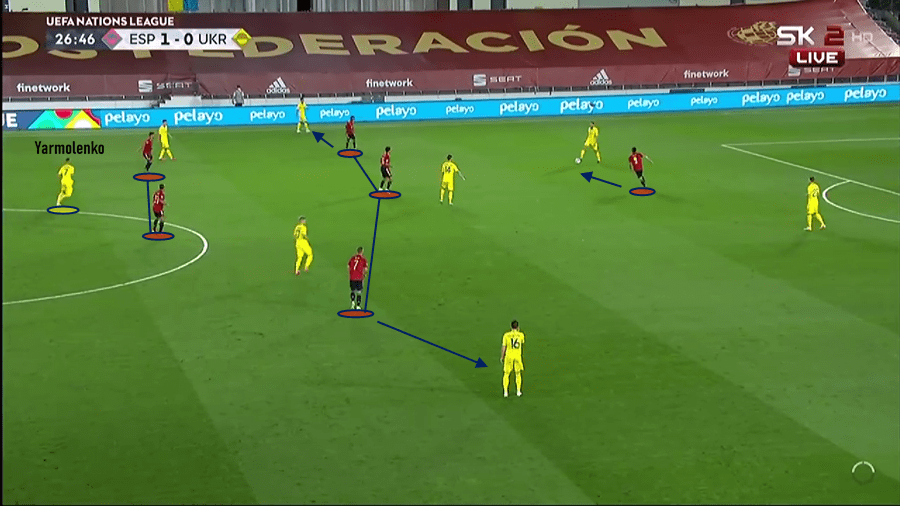
Moreno would begin in between the two centre-halves and press the one with the ball. Behind him, Thiago would frequently push up, positioning himself in line with the two (tucked in) wingers. He would screen the midfield two ahead of him and aim to cut the passing lanes to Ukraine’s more advanced players. This subtle but clever trick forced Ukraine wider, where the wingers and full-backs of Spain could pounce to win the ball back. With Rodri and Merino acting almost as a double-pivot too, any long ball along the ground to the front three was closed off, and they could also get close to Ukraine’s most technical midfielders – Zinchenko and Malinovskiy.
Ukraine were frustrated with their inability to make consistent attacking progress. Although they opted for balls in behind, they liked to play these on the ground, and so they were often shut off. Ukraine’s front three struggled to maintain any form of shape as they became increasingly dissatisfied with the lack of service they received. Left-winger Yarmolenko can be seen way out of position in the centre of the pitch in the still above.
Conclusion
This analysis showed that despite Ukraine’s attempts to sit off, Spain’s utilisation of the wide areas (coupled with the fact that Fati had a terrific game) meant that they still posed a direct attacking threat. For the most part, Spain pressed intelligently and defended with comfort. Ukraine, led by a good performance from Zinchenko in midfield, aimed to hit Spain wide on the counter, but their opponents were too well-organised, and Spain ultimately came away with a clean sheet and all three points. It was a smart and measured performance at both ends of the pitch by Spain, who came out of the game 4-0 victors and ended the night top of the group. Despite the loss, Ukraine retained second place, with a game against Germany to come.





Comments